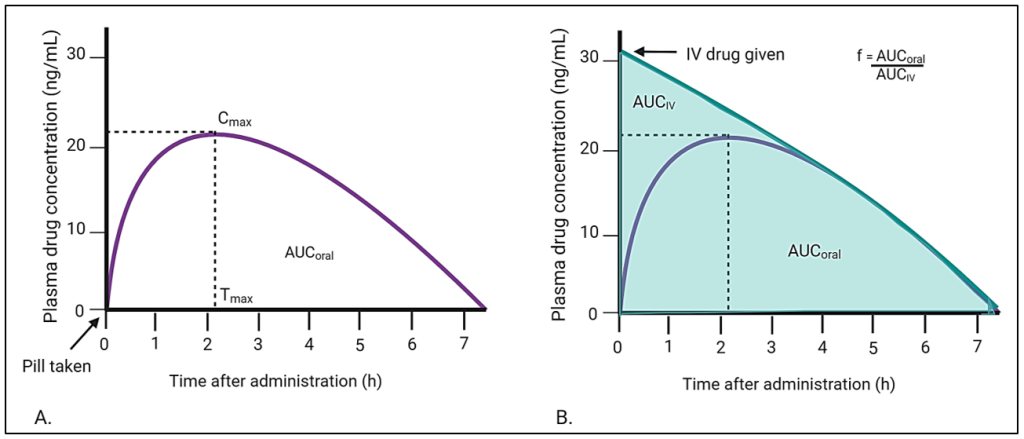A. Pharmacology and Drug Actions
Pharmacology is the study of drugs and their effects. A drug is a substance or chemical agent which can affect living processes – and can be a natural product, chemical substance, or pharmaceutical preparation for administration to a human or animal. Most drugs are used to treat the sick or a health condition; thus, pharmacology is a part of the broad science of medicine[1]. More broadly, pharmacology is concerned with the mode of action of drugs on the human body, and the use of drugs in therapies. (Not to be confused with pharmacy – the science and profession concerned with preparing, storing, dispensing and proper use of drug products). Toxicology is the branch of pharmacology that generally deals with the undesirable effects of drugs on biological processes[2].
| Pharmacokinetics | Study of what the body does to the drug | Refers to the movement of a drug going into, through, and out of the body; processes that determine the concentration of drugs in body fluids and tissues over time: drug absorption, distribution, metabolism and excretion |
| Pharmacodynamics | Study of what the drug does to the body | Refers to how drugs work and how they exert powers or effects on the body via target receptors and tissues: receptor binding, signal transduction, dose-response |
Pharmacology includes two main subdivisions: pharmacokinetics and pharmacodynamics.
Pharmacokinetics describes what the body does to the drug. In order for a drug to “work”, it must enter the body and somehow reach a site of action. In most cases the site of action is a receptor located in a target tissue.[3] A receptor is a cellular bound or unbound macromolecule with structural specificity. When a receptor becomes bound or activated by a drug, it undergoes a conformational change that alone or through a series of chain reactions can manifest an effect.[4] A drug effect could be increasing of a secretion, a change in metabolism, inhibition of an enzyme, and so on.
Pharmacokinetics is concerned with processes that bring about changes in drug plasma concentration and the concentration of drugs in tissues over time. The concentration of any given drug will fluctuate according to the rates of four processes: absorption, distribution, metabolism and excretion; thus, interactions with nutrients may involve enzymes and transporters that are implicated in any of these processes.[5]
Pharmacodynamics describes what the drug does to the body, and involves the study of the actions of drugs on target receptors and tissues. As mentioned above, the majority of drugs bind to specific receptors on the surface or interior of cells; however, there are other cellular components and non-specific sites which can serve as sites of drug action. Hydrogen and metal ions, enzymes, nucleic acids or macromolecular receptors can also be drug targets.[6]
Drug Plasma Concentration Curves
Following oral drug administration, plasma concentration typically increases over time. A standardized drug plasma concentration curve is shown in Figure 1.1 A below. In Figure 1.1, the y-axis is a linear scale of drug plasma concentration, often expressed in micrograms per milliliter or milligrams per liter, and the x-axis is a scale of time, usually expressed in hours. The maximal plasma drug concentration for a single dose of a drug given orally is known as maximum concentration (Cmax) and the time to time necessary to reach the Cmax is known as the Tmax, see Panel A.[7]

Figure 1.1. Plasma drug concentration and drug bioavailability[8]
Drug plasma concentration curves help us understand concepts such as bioavailability, which is defined as the fraction (f, in Figure 1.1.B) of the administered dose of a drug that reaches the systemic circulation in an active form. By definition, an intravenously administered drug has 100% bioavailability. The oral availability of a drug is determined by dividing the AUC of an orally administered dose of the drug (AUCoral) by the AUC of an intravenously administered dose of the same drug (AUCIV).[9]
- Brenner GM, Stevens CW. Pharmacology. Fifth edition. ed. 1 online resource (579 pages) p. ↵
- Brenner GM, Stevens CW. Pharmacology. Fifth edition. ed. 1 online resource (579 pages) p. ↵
- Brenner GM, Stevens CW. Pharmacology. Fifth edition. ed. 1 online resource (579 pages) p. ↵
- Brenner GM, Stevens CW. Pharmacology. Fifth edition. ed. 1 online resource (579 pages) p. ↵
- Brenner GM, Stevens CW. Pharmacology. Fifth edition. ed. 1 online resource (579 pages) p.; Boullata JI, Armenti VT, SpringerLink (Online service). Handbook of drug-nutrient interactions. New York, NY: Humana Press; 2010. ↵
- Brenner GM, Stevens CW. Pharmacology. Fifth edition. ed. 1 online resource (579 pages) p. ↵
- Brenner GM, Stevens CW. Pharmacology. Fifth edition. ed. 1 online resource (579 pages) p. ↵
- Brenner GM, Stevens CW. Pharmacology. Fifth edition. ed. 1 online resource (579 pages) p. ↵
- Brenner GM, Stevens CW. Pharmacology. Fifth edition. ed. 1 online resource (579 pages) p. ↵
The study of drugs and their effects
A substance or chemical agent, which can affect living processes - and can be a natural product, chemical substance, or pharmaceutical preparation for administration to a human or animal
What the body does to a drug
Cellular bound or unbound macromolecule with structural specificity
Movement of drugs from their site of administration into the vascular bed; influenced by many factors
The volume in an organism throughout which a drug appears to have been distributed; the volume into which a drug appears to have been dissolved after administration to an organism
The chemical reactions that convert drugs into compounds that are easier for the body to eliminate and excrete; also known as biotransformation
The process of eliminating a drug from the body; there are several routes for drug elimination from the body (sweat or skin; via kidney to urine; via liver to feces, etc.)
What a drug does to the body
